Menus
- Milestone in the 750s
- Weight in the 90s real sensation
- Model history – GR7DB, type T to GR7DB, type W / X
- Market situation
- technology
- Michael Schaffer on the Suzuki GSX-R 750 SRAD
- survey
- Conclusion
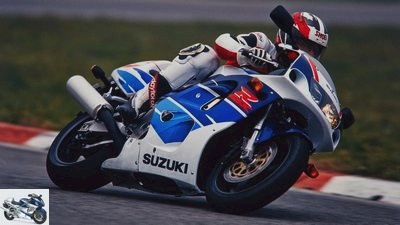
Achim Hartmann, Jorg Kunstle, Frank Herzog, MOTORRAD archive
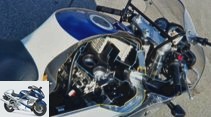
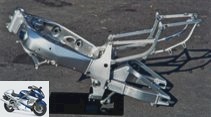
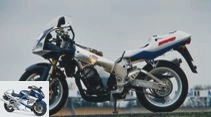
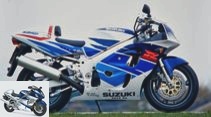
11 photos
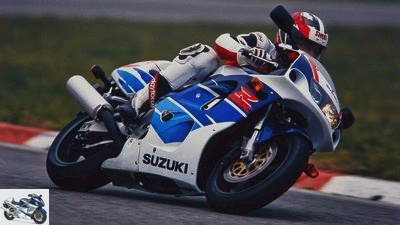
Achim Hartmann, Jorg Kunstle, Frank Herzog, MOTORRAD archive
1/11
In 1996, Suzuki turned its super sports car completely inside out, radically reduced its weight and increased its performance.

Achim Hartmann, Jorg Kunstle, Frank Herzog, MOTORRAD archive
2/11
The GSX-R with thin walls on the tank.

Achim Hartmann, Jorg Kunstle, Frank Herzog, MOTORRAD archive
3/11
Bridge frame made entirely of aluminum with Ram Air inlets, screwed-on rear frame and swing arm with cover.
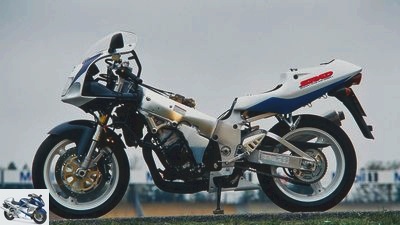
Achim Hartmann, Jorg Kunstle, Frank Herzog, MOTORRAD archive
4/11
The carburetors blink greedily over the frame. They want to be fed with air via ram air and fuel.
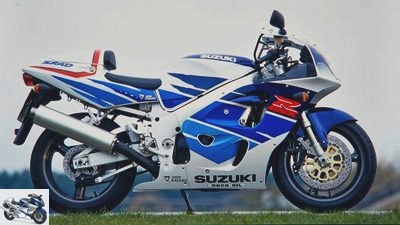
Achim Hartmann, Jorg Kunstle, Frank Herzog, MOTORRAD archive
5/11
Suzuki GSX-R 750 SRAD (GR7DB, Type T) from 1996: In addition to the engine, frame and intake system, the design of the SRAD, which was aerodynamically optimized in the wind tunnel, stood out.
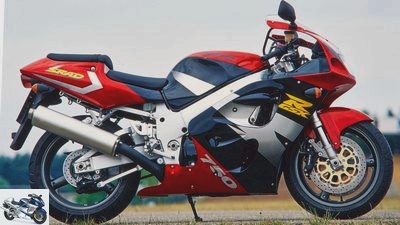
Achim Hartmann, Jorg Kunstle, Frank Herzog, MOTORRAD archive
6/11
Suzuki GSX-R 750 SRAD (GR7DB, Type U): After the SRAD was presented as a new model in 1996, Suzuki changed the design of the super sports car in 1997.

Achim Hartmann, Jorg Kunstle, Frank Herzog, MOTORRAD archive
7/11
Suzuki GSX-R 750 SRAD (GR7DB, Type W / X): In 1998/1999 the injection replaced the carburetor, the volume of the airbox grew by 50 percent.

Achim Hartmann, Jorg Kunstle, Frank Herzog, MOTORRAD archive
8/11
Typical SRAD: the voluminous hump.

Achim Hartmann, Jorg Kunstle, Frank Herzog, MOTORRAD archive
9/11
In 1997 Udo Mark switched to Suzuki and collected points and trophies with the GSX-R 750 SRAD.

Achim Hartmann, Jorg Kunstle, Frank Herzog, MOTORRAD archive
10/11
The Showa damper cost 20,271 marks, worked great, but it was changed to Ohlins.
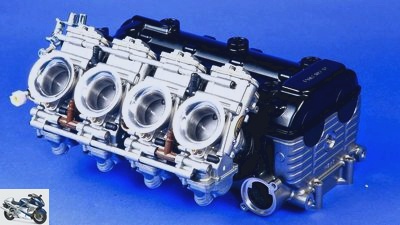
Achim Hartmann, Jorg Kunstle, Frank Herzog, MOTORRAD archive
11/11
In 1996 flat slide 40 carburettors were used, and in 1997 even 42 carburettors were used.
Suzuki GSX-R 750 SRAD in the youngtimer check
Milestone in the 750s
Content of
The Suzuki GSX-R 750 SRAD (model type GR7DB, type T to GR7DB, type W / X) had only one goal: to become the best bike in the 750cc class. In 1996, Suzuki turned its super sports car inside out, radically reduced its weight and increased its performance.
For Suzuki that was GSX-R 750 SRAD a milestone. Gone are the days when an old engine was surrounded by a consumptive aluminum double loop frame, when the ratio of power to weight was no longer up to date. The SRAD changed that fundamentally. But it did not start a revolution because its ingredients for more sportiness had long been known. Aluminum bridge frames were already available in 1996 on the Kawasaki ZX-7R or the Yamaha YZF 750, carburettors in downdraft arrangement anyway, and a Ram-Air was already known since the Kawasaki ZXR 750. And yet the GSX-R 750 aimed with power on the throne of the superbikes.
Weight in the 90s real sensation
From the 750s to the Ducati 916, which competed as a two-cylinder in the superbikes, it still had a really big ace up its sleeve – its weight. The GSX-R weighed only 204 kilograms. What is not unusual today was a sensation in the mid-1990s, after all, all other superbikes weighed a few kilograms more. At 215 kilos, the Duc was still relatively close to the Suzuki, Yamaha’s YZF 750 R and the then also brand-new ZX-7R from Kawasaki weighed 229 and 234 kilograms, respectively. The SRAD mercilessly capitalized on this drop in pounds, shining in the first comparison test among the four mentioned bikes in PS 1/1996 with fantastic handiness – and that despite the fat rear tire on the 6-inch rim.
In addition, at the time, with a measured 128 hp, it penetrated completely new performance regions in the Superbike class. Up to now, such power could only be achieved with engine tuning and loud roaring bags. Nevertheless: In the first exchange of blows, the new GSX-R 750 SRAD only took second place behind the Kawa, which was mainly due to its slightly rear-heavy seating position. Suzuki did not change anything during the four-year construction period. The same applies to other standards that the SRAD has set, at least among the Suzuki super athletes. So she established the aluminum bridge frame among the four-cylinder sports bikes from Hamamatsu, just like a Ram-Air (Suzuki Ram Air Direct).
Model history – GR7DB, type T to GR7DB, type W / X
Suzuki GSX-R 750 SRAD (GR7DB, Typ T) 1996
Achim Hartmann, Jorg Kunstle, Frank Herzog, MOTORRAD archive
Suzuki GSX-R 750 SRAD (GR7DB, Type T) from 1996: In addition to the engine, frame and intake system, the design of the SRAD, which was aerodynamically optimized in the wind tunnel, stood out.
The engine, frame and intake system have already been mentioned in detail. In addition, the design of the SRAD, which was aerodynamically optimized in the wind tunnel, stood out. The hump with its rounded shape takes this into account. The new four-in-one exhaust system makes an important contribution to the low weight of the machine.
Suzuki GSX-R 750 SRAD (GR7DB, Typ U) 1997
Achim Hartmann, Jorg Kunstle, Frank Herzog, MOTORRAD archive
Suzuki GSX-R 750 SRAD (GR7DB, Type U): After the SRAD was presented as a new model in 1996, Suzuki changed the design of the super sports car in 1997.
After the SRAD was presented as a new model in 1996, Suzuki changed the design of the super sports car in the second year. The cylinder head gasket was also modified. The original version had to be swapped three times in the endurance test of sister magazine MOTORRAD during the 50,000 kilometer distance.
Suzuki GSX-R 750 SRAD (GR7DB, Typ W / X) 1998/1999
Achim Hartmann, Jorg Kunstle, Frank Herzog, MOTORRAD archive
Suzuki GSX-R 750 SRAD (GR7DB, Type W / X): In 1998/1999 the injection replaced the carburetor, the volume of the airbox grew by 50 percent.
Injection replaced the carburettors, and the volume of the airbox grew by 50 percent. The final translation was shorter, the tuning of the spring elements was revised. In addition, the "W." a new timing chain tensioner including slide rail with metal inlay. For the X model, there was another update for the timing chain tensioner and a new design.
Market situation
The fifth generation of the GSX-R 750 enjoyed great popularity despite polarizing optics (keyword humps). From 1996 to 1999, 5,090 copies of the three-quarter Gixxer with the abbreviation SRAD were sold in Germany, which is also reflected in today’s used market. There is a wide range of offers, and if you want to get a taste of super sports at a low price, you will find a good partner in SRAD. The original SRAD with carburettor, built in 1996 and 1997, and the further development with injection, built in 1998 and 1999, do not differ in price. Copies that are on the market go into your own garage from 1,200 euros, but these often have a high mileage of more than one trip around the world behind them.
In principle, machines with less than 25,000 kilometers are very rare, if one is found, it usually costs 3,000 euros or more. Important for all: You should be in a checkbook. While the chassis components and the frame age well, the engine can certainly cause problems, especially when it comes to racetrack booby. The first SRAD (model T) had a cylinder head gasket that was too thin, which was also adopted three times in the MOTORRAD 50,000 kilometer endurance test of that time. This problem has been resolved since 1997. In the endurance test motorcycle, the cylinder head also warped. In addition, the piston pins and the upper connecting rod bearings showed heavy wear. The timing chain tensioner also often causes problems, so it is essential to watch out for unusual noises in this area. The model W from 1998 with injection eliminated many of these devils of defects and is more steadfast, despite seven horsepower more power.
technology
When developing the SRAD in 1995, Suzuki left no stone unturned. The list of changes to the previous model would go beyond the scope here. Keyword frame: In order to cope with the ever increasing power of the engines, the SRAD has an aluminum bridge frame with a straight connection from the steering head to the swing arm bearing, derived from the former GP rifle RGV 500. The pistons of the SRAD’s 128 hp engine whiz With coated aluminum cylinders, the camshaft drive is on the right-hand side and rotates a crankshaft one kilogram lighter than its predecessor.
Achim Hartmann, Jorg Kunstle, Frank Herzog, MOTORRAD archive
The GSX-R with thin walls on the tank.
The engine breathes through a 39 carburettor in a downdraft arrangement. For more flavor, the carburettors are from "Suzuki Ram Air Direct"-System (SRAD) pressurized. With this technology, the airflow is pressed directly into the airbox via intake ducts in the front – that was already remarkable back then. The 750 Suzuki indulges in lightweight construction with hollow-drilled screws and wheel axles, circuit board instruments and aluminum wherever you look. The GSX-R, which weighs 204 kilograms, is kept on course at the front by a fully adjustable 43-millimeter fork, while at the rear a completely customizable spring strut dampens. From 1998 the carburetor battery gave way to an injection system which, in combination with a new airbox (50 percent more volume), increased the power to 135 hp.
Michael Schaffer on the Suzuki GSX-R 750 SRAD
As the chief technician, Michael Schafer looked after the Suzuki Germany Superbike team for many years – including when the GSX-R 750 SRAD was racing.
PS: You followed the Suzuki GSX-R 750 SRAD’s entry into racing first hand. The SRAD was a good basis for a racing bike?
Shepherd: Back then, the Suzuki was the best basis for use as a race bike, compared to the other models in this class. In terms of performance, the SRAD was the strongest motorcycle in the field, and Yamaha couldn’t match that with the 750, just like Kawasaki or Honda. It stayed that way with the racing motorcycle. When it came to power, the SRAD came out on top in the Pro Superbike class.
PS: To introduce the GSX-R 750, Suzuki presented a racing kit. Was the kit a blessing or a curse? After all, the engine alone cost 82,000 marks – more than four times as much as a complete series SRAD.
Shepherd: The kit brought a lot. At that time it was the case that with a pre-series SRAD as a race bike we were already able to achieve an output of 152 hp on the rear wheel. With the installation of the racing kit, the power increased to 162 hp – also on the rear wheel. That was the peak value for the carburetor SRAD. When the injection GSX-R 750 came on the market, we achieved a further increase in output to 172 hp. The bikes – which came to us as complete factory motorcycles – were able to develop their full potential with the kits. That’s why we used all the kit parts for the engine.
PS: What were the decisive parts from the engine kit to increase the SRAD’s standard output of 128 hp so blatantly?
Shepherd: The most important parts were camshafts, pistons and connecting rods. You didn’t have to use the kit’s crankshaft. It weighed as much as the series part, consisted only of a different material and had weights that were welded and not screwed. The cylinder heads, which came straight from the factory, also contributed to the increase in performance. We even reworked it to get a few more horsepower out of the engine. The kit also included the carburettors, which also brought more power. In 1996 we used flat slide valves with an intake diameter of 40 millimeters, in 1997 we then used 42 flat slide carburetors.
PS: The noble parts in addition to the engine parts also included expensive chassis parts from Showa – they were necessary?
Shepherd: The parts belonged to the racing kits of the factory machines and were great in themselves. Nevertheless, we switched to Ohlins for the SRAD racers because Ohlins was already able to offer complete service support including a technician in the Pro Superbike championship. For the Showa parts, I would have had to take care of the coordination for our riders – and apart from setting up and looking after the racing bikes, I couldn’t have done that anymore.
PS: With Udo Mark, the SRAD won third place in the Pro Superbike classification in 1997 and 1998. With all the effort – why, in your opinion, didn’t it reach all the way forward??
Shepherd: The problem was that we started with Pirelli in the first year. At the time, they came onto the market with a brand new slick, which, however, did not quite reach the quality of the established competitors, especially in terms of durability. The SRAD itself ran great. With Andy Hoffmann we achieved a top speed of 302 km / h at the Superbike World Championship run in Hockenheim. Only Aaron Slight on his Honda was faster back then. In the following years we switched to Dunlop, but Udo Mark was unable to start in some races due to a fractured thoracic vertebra. Therefore, a third place in the overall standings against the strong competition was a top result.
survey
Voted 723 times
Suzuki GSX-R 750 SRAD: top or flop?
I’m a huge fan!
Not my thing …
read more
Conclusion
For Suzuki, the GSX-R 750 SRAD ushered in a whole new era in sports motorcycle construction, the legacy of which the current GSX-R models continue to this day. Even today, the SRAD is a popular alternative when it comes to cheap super sportsmen and women.
Related articles
-
Yamaha FZR 1000 in the youngtimer check
Frank Herzog, MOTORRAD Archive, Yamaha 14th photos Frank Herzog, MOTORRAD Archive, Yamaha 1/14 An unthrottled FZR 1000 was considered the speed bike par…
-
Suzuki GSX-R 750 and Yamaha FZ 750
Hartmann 15th photos Hartmann 1/15 For the 100th birthday of the motorcycle 30 years ago, the most beautiful gifts came from Japan: Suzuki‘s GSX-R 750,…
-
fact Test: Suzuki GSX-R 1000 from 2006 and 2012 Kilo-Gixxer in a generation comparison Content of Suzuki’s GSX-R 1000 from 2005/2006 enjoys cult status…
-
Test: the new Suzuki GSX-R 750
Suzuki Premiere: Suzuki GSX-R 750 2011 First kilometers on the racetrack with the 750 Gixxer Content of Suzuki has stuck to her since 1985. Wherever the…
-
Triumph Daytona 675, Kawasaki ZX-6R 636 and Suzuki GSX-R 750 in the test
fact 20th photos fact 1/20 Super athletes with less than 1000cm³ in the comparison test. Suzuki GSX-R 750, Kawasaki ZX-6R 636 and Triumph Daytona 675….
-
Endurance test final balance Suzuki GSX-R 1000
Jelicic, Bilski, Koch, Sdun 30th photos Suzuki 1/30 Suzuki 2/30 Suzuki 3/30 Suzuki 4/30 Suzuki 5/30 Suzuki 6/30 Suzuki 7/30 Suzuki 8/30 Suzuki 9/30…
-
Comparison test: Suzuki GSX-R 600 2010-2011
Comparison test: Suzuki GSX-R 600 2010/2011 Suzuki GSX-R: New versus old Content of The engines of the two Suzuki GSX-R 600 roar sharply -…
-
Comparison test MV Agusta F4 S against Suzuki GSX-R 750
Comparison test MV Agusta F4 S against Suzuki GSX-R 750 Pasta sushi Either al dente enjoyment, cooked by a master hand. Or raw fish, light, rich in…
-
Dream bike choice Suzuki GSX-R 1000
www.factstudio.de 44 photos Suzuki 1/44 Everything about the technology of the Suzuki GSX-R 1000 in MOTORRAD 1/2005 (in stores from December 17th)….
-
Suzuki GSX-R 1000 R Ryuyo special model
Suzuki Italy Suzuki GSX-R 1000 R Ryuyo special model 212 hp meet 168 kilograms Suzuki Italy will present a very hot GSX-R 1000 R at EICMA. The special…